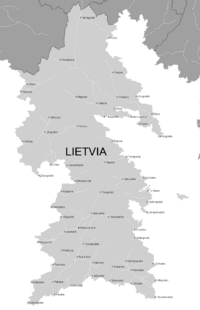Lietvia: Difference between revisions
No edit summary |
No edit summary |
||
| Line 127: | Line 127: | ||
|footnotes = <!--For any generic non-numbered footnotes--> | |footnotes = <!--For any generic non-numbered footnotes--> | ||
}} | }} | ||
'''Lietvia''', formally known as the '''Republic of Lietvia''' (Lietvian: '''Republika Lietvaine''') is a parliamentary republic governed by a Prime Minister. The peninsular nation of over 161 million people, spanning over 722,000 km, consists of 14 provinces and 2 overseas autonomous regions. Lietvia resides within the Lietvian Sea in the northern hemisphere, bordering Omskaya, Lakvaniya, and Abvekhia to the north. Lietvian is the official language of Lietvia, but the nation also recognises English as a national language, with the vast majority of the population being bilingual between Lietvian and English. Some Lietvians also speak {{wp|Ukrainian language|Omskayan}}, {{wp|Chinese language|Xia}}, and Axtleca, being part of the most prevalent ethnic minorities in the country. | |||
The modern Lietvian republic was formed with the fall of the [[Lietvian Empire]] and the [[Lietvian transition to democracy]], an 8 year long process which saw the total reformation of Lietvian government structure, formation of new organizations to fit a republican model, the abdication of the Lietvian monarchy, and a series of several short-lived insurrections. As the nation transitioned into democracy, it formally relinquished its control of several overseas colonies, but retained administration over [[Xiahai]] and [[Axtlán]]. | |||
Lietvia is a highly developed country with one of the world's highest GDPs and a high GDP per capita. It is the largest economy within the Lakvan subcontinent. Its citizens enjoy some of the world's fastest internet speeds, efficient high-speed transport, and an extensive social welfare system, including efficient healthcare, education, and nutrition. Lietvia is a global leader in research and development, technology, and science related fields. Lietvia is a great power, retaining extensive influence within the Lakvan subcontinent and the world. It is a recognised nuclear weapons state, possessing a {{wp|nuclear triad}}, and maintains one of the highest defence expenditures in the world. | |||
Latest revision as of 17:57, 27 February 2020
Republic of Lietvia Republika Lietvaine | |
|---|---|
|
Flag | |
 | |
| Capital | Mekhankaiste |
| Largest city | Majagraide |
| Official languages | Lietvian |
| Recognised national languages | English |
| Ethnic groups | 81% Lietvian 7% Omskayan 6% Xia 4% Axtleca 2% other |
| Religion | 52% Catholic 37% irreligious 3% Buddhist 3% Orthodoxy 5% Unknown |
| Government | Unitary parliamentary democracy |
• Prime Minister | Denis Kozlinys |
| Legislature | Viskene Lietvaine |
| Establishment | |
| 1521-1950 | |
| 1950-1958 | |
• Current democracy | 1958 |
| Area | |
• | 722,672 km2 (279,025 sq mi) |
| Population | |
• 2020 census | 161,822,964 |
• Density | 223/km2 (577.6/sq mi) |
| GDP (PPP) | 2020 estimate |
• Total | $7.805 trillion |
• Per capita | $48,231 |
| GDP (nominal) | 2020 estimate |
• Total | $7.150 trillion |
• Per capita | $44,187 |
| Gini | 34.1 medium |
| HDI (2020) | very high |
| Currency | Lita (LTA) |
| Driving side | right |
| Internet TLD | .rl/.co.rl |
Lietvia, formally known as the Republic of Lietvia (Lietvian: Republika Lietvaine) is a parliamentary republic governed by a Prime Minister. The peninsular nation of over 161 million people, spanning over 722,000 km, consists of 14 provinces and 2 overseas autonomous regions. Lietvia resides within the Lietvian Sea in the northern hemisphere, bordering Omskaya, Lakvaniya, and Abvekhia to the north. Lietvian is the official language of Lietvia, but the nation also recognises English as a national language, with the vast majority of the population being bilingual between Lietvian and English. Some Lietvians also speak Omskayan, Xia, and Axtleca, being part of the most prevalent ethnic minorities in the country.
The modern Lietvian republic was formed with the fall of the Lietvian Empire and the Lietvian transition to democracy, an 8 year long process which saw the total reformation of Lietvian government structure, formation of new organizations to fit a republican model, the abdication of the Lietvian monarchy, and a series of several short-lived insurrections. As the nation transitioned into democracy, it formally relinquished its control of several overseas colonies, but retained administration over Xiahai and Axtlán.
Lietvia is a highly developed country with one of the world's highest GDPs and a high GDP per capita. It is the largest economy within the Lakvan subcontinent. Its citizens enjoy some of the world's fastest internet speeds, efficient high-speed transport, and an extensive social welfare system, including efficient healthcare, education, and nutrition. Lietvia is a global leader in research and development, technology, and science related fields. Lietvia is a great power, retaining extensive influence within the Lakvan subcontinent and the world. It is a recognised nuclear weapons state, possessing a nuclear triad, and maintains one of the highest defence expenditures in the world.
